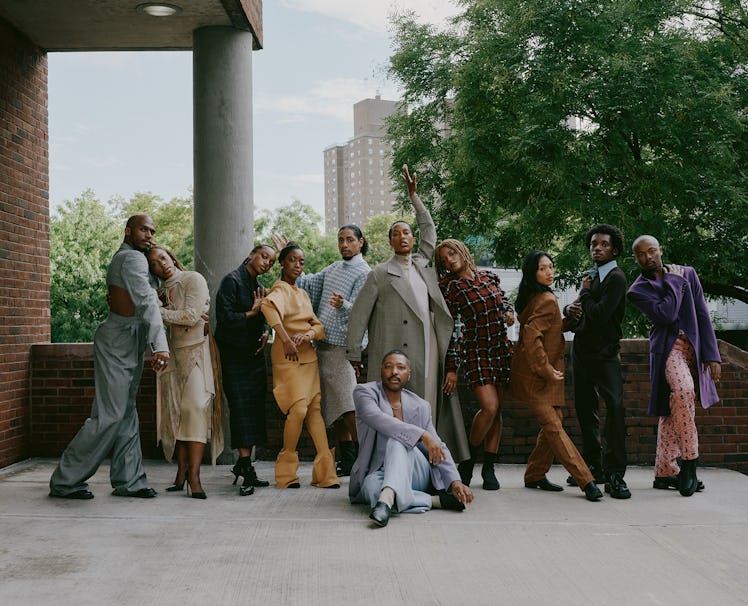For Choreographer Kyle Abraham, Dance Is a Reflection of Life

For W’s annual The Originals portfolio, we asked creatives—pioneers in the fields of art, music, food, dance, fashion, and more—to share their insights on staying true to themselves. See this year’s full class of creatives here.
You are one of the most sought-after figures in the world of contemporary dance. You’ve won a MacArthur Fellowship and collaborated with everyone from Misty Copeland to Beyoncé. Your dance company, A.I.M by Kyle Abraham, has set itself apart with its fresh, dynamic performances. Tell us a little bit about your early relationship with dance.
I’ve loved dancing since I can remember. I got kicked out of Catholic school on the very first day—for dancing. When I was 17, the summer before my senior year, I saw the Joffrey Ballet perform a program that was set to Prince’s music. As a big rave and hip-hop kid, I was so blown away by this different way of moving that it made me want to study dance.
Is starting at 17 considered late in the dance world? Did you feel like you had catching up to do?
Yeah, but this is my personality: I’m the constant underdog in life. Even today, I still feel like I’m trying to play catch-up, or constantly humbling myself when I’m in certain spaces.
I’ve heard your work described as “dance with purpose.” Does that resonate with you?
Listen, I’m going to take it, because it sounds positive. There’s a lot of weight being an artist of color. If I’m making a piece, whether I’m meaning for it to be political or not, I have to be aware that if I have even just a singular Black body in space, it’s considered political, let alone if I have a white dancer standing in front of, or standing in back of, a dancer of color. People will find some political lens to put onto it. So I do have to have some kind of purpose behind any- and everything I’m doing, even in its most abstracted form.
I saw A.I.M at the Joyce earlier this year, in a showcase presented by Dance Reflections by Van Cleef & Arpels, and I was struck by how narrative some of the dances were. And in one piece, there were flashes of humor—the audience was laughing!
I love finding moments to inject humor. I made The Radio Show back in 2010, about the only urban radio station in my hometown of Pittsburgh being taken off the air while my father had dementia and aphasia. About 15 minutes in, one of the dancers was doing this really powerful solo to Aretha Franklin’s “Mary, Don’t You Weep.” And then I decided to break into some pop culture choreography to readjust the brain a bit and shake things up. It’s a reflection of the reality of life, especially in an urban setting. It’s like, if you’re on the subway or walking down the street, you can be in your own world, listening to your music or reading your book, and then someone can come in and disrupt that. Those wake-ups help you realize that there’s only so much control we have in our lives.
In the past, you’ve held “activations” in some of the venues at which A.I.M has performed. At the Kennedy Center, in Washington, D.C., you organized a series of card games in a gathering space that audience members could join. How does that relate to what you do on the stage?
I’m making work for the culture. It should extend beyond a performance practice. With An Untitled Love, we had this idea of playing card games that a lot of people would’ve grown up playing in the Black community, like Spades, Bid Whist, Tonk, or 500. Other times, we’ll do a brunch the following day instead of a discussion after the show, which can sometimes feel a little performative, even from an audience perspective. It’s like, are you asking that question because you really want to know the answer? Or do you want people to hear you speak? At brunch, you can sit and have a conversation and just vibe out. We do a variety of workshops where we’re engaging people in a way that is not about getting them to the theater. How can we have a conversation around who we are, what we represent, and what we want to be seeing here in this world?
What would you say distinguishes A.I.M as a company? What are you most proud of?
We offer our dancers 52-week salaries, with health care and retirement plans, which is rare. I can thank Sydnie Liggett-Dennis, our executive director, for that. And we have summer and winter intensives that are completely free, which is crazy because those are actually where a lot of dance companies make most of their money. When we do those and I hear people within the community talking about how inspired they have been from what we do, it’s pretty magical and special—but also sometimes stressful. Because you’re like, Oh, I got to keep going, huh? I can’t take a break.
What would you say to people who consider contemporary dance to be an overly abstract, “serious,” or impenetrable art form?
People say, “I don’t understand dance.” I’m like, “Well, did you understand that Jackson Pollock painting? You still go to the museum.”
Hair by Chika Nishiyama; makeup by Caroline Baribeau; digital tech: Ian Robertson; photo assistant: Denzel Golatt; fashion assistants: Isma Andrade, Sam Falb, Jamila Jabulani; hair assistant: Shonosuke Chiba; makeup assistants: Stella Bouzakis, Alex Pacheco, Tiffany Rodriguez, Angela-Lynn Ware. Special thanks to the Abrons Art Center in New York City, and Maassai Collier.
This article was originally published on